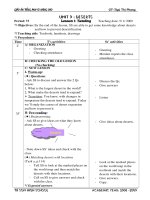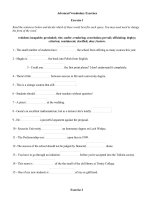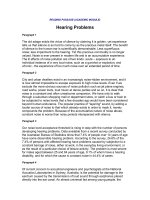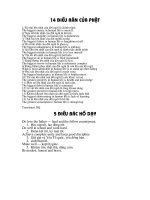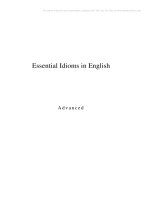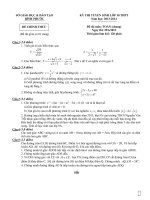2014 advanced vent modes
Bạn đang xem bản rút gọn của tài liệu. Xem và tải ngay bản đầy đủ của tài liệu tại đây (1.67 MB, 28 trang )
Mechanical Ventilation:
Advanced Ventilator Modes
AATS/STS Cardiothoracic Critical Care Symposium
AATS Annual Meeting
Toronto, Canada
April 27th 2014
No Disclosures
Aaron M Cheng, MD FACS
University of Washington
Division of Cardiothoracic Surgery
Co‐Director, UWMC Cardiothoracic ICU
Seattle, Washington
Mechanical Ventilation:
SUPPORTIVE NOT THERAPEUTIC
• Airway protection
• Support gas exchange
• Reduce work of breathing
Different Vent Modes:
ALL Use Positive Pressure Ventilation
• Vent MODES: Differences
in how PPV is applied
• PPV LUNG INJURY
• ALL VENT MODES CAN
CAUSE LUNG INJURY
Mechanical Ventilator Support
DIFFERENT VENT MODES
PSV
NAVA
PAV
Volume‐AC
Pressure‐AC
PRVC
APRV
HFOV
HFPV
Ventilator Basics
4 Phases during Ventilator Cycle
Breath Initiation
Flow delivery phase
Breath termination
Expiratory phase
Control Variables (Target)
• Pressure, Volume/Flow
Phase Variables
• Trigger—Initiation of inspiratory
phase: Pressure, Flow, or Time
• Limit– Sustains inspiratory cycle eg.
Limit flow 50 L/min
• Cycle– Ends inspiratory cycle eg. Cycle
at TV 500 ml
• Baseline– Usually passive‐‐depends on
airway resistance & lung elastance
Conditional Variables
IfThen programming eg.
Switching to patient trigger
from machine trigger
Assist‐Control (AC):
Most common ICU vent mode
• Control: Pressure or Volume
• Trigger: (Patient effort & sensitivity)Pressure,
Flow, or (Machine)Time
• Limit: Pressure, Flow, or Volume
• Cycle: (Machine) Flow, Volume, Pressure, Time
Pressure or Volume:
Is there a difference?
Assist Control‐‐VOLUME
Advantages
Disadvantages
Constant Tidal Volume (Vt)
Peak alveolar pressure are
variable‐‐Over distension
risk
PaCO2 constant
Cannot respond to changes
in ventilator demand‐‐flow
limited
Changes in Peak Inspiratory
pressure easy to detect
Assist Control‐‐PRESSURE
Advantages
Disadvantages
Peak alveolar pressure is
limited
Vt is variable
Flow responds to patient
PaCO2 can vary
Better vent synchrony
Decelerating flow waveform
• Decelerating flow
waveform
– Increased mPaw
– Decreased PIP
– Improved
oxygenation
Dual Modes: Combines features of
pressure & volume target to achieve
goals of ventilation
• Known by different names
– Volume Assured Pressure Support
• Pressure Augmentation
– Pressure Regulated Volume Control
• Auto‐flow
• Variable Pressure Control
Dual Modes: Pressure regulated
volume control (PRVC)
• Pressure control waveform
but “guaranteed tidal
volume”
• Ventilator (Machine) adjusts
Pressure target to least value
needed to maintain minimum
Tidal Volume target
Pressure control compared to PRVC
PCV: Pressure remains constant
and volume changes (decreases)
due to changes in lung
compliance
PRVC: Pressure target is adjusted
to changes in compliance to meet
volume target
Rescue Ventilator Modes:
APRV
Hi Frequency Oscillation
Airway Pressure Release Ventilation
• “Inverse‐ratio” Bi‐
Level Mode
• Maintains Lung
Volume throughout
cycle
– CO2 clearance occurs • Settings
– PHigh & PLow
with pressure release
& spontaneous
– THigh & TLow
breathing
APRV: Spontaneous Breathing
Reported benefits of APRV
• Decreases VILI
– Reduces peak airway pressures
• Promotes improved aeration at lung bases—
where atelectasis commonly occurs
• Allows patient to breathe while providing
“OPEN” lung ventilation
– Less sedation needed
• Improves oxygenation
– Higher mean airway pressure (mPaw)
The role of APRV
• Frequently used in awake patients with
moderate‐severe ARDS
– Decreased sedation requirement less vasoactive
requirements
• Improved aeration & cardiovascular stability
lost when patient unable to breathe
spontaneously
– Can be detrimental in patient with high ventilatory
requirements & severe obstructive lung disease
• Hyperinflation High alveolar pressure Barotrauma
High Frequency Oscillation:
OSCILLATE & OSCAR
Multi‐center randomized controlled trials comparing
Adult patients with ARDS to treatment with Conventional
mechanical ventilation versus HFOV
OSCILLATE trial terminated early due
to increased in‐hospital mortality in
the HFOV arm (47% versus 35%)
OSCAR trial demonstrated no
difference in 30‐day mortality
between groups: HFOV was not
superior
Adaptive Ventilator Modes:
Adapting the ventilator to the patient
(Better synchrony through technology)
Increasing Ventilator Assistance
PAV
NAVA
Pressure
Support
Increasing Patient Effort
Proportional Assist Ventilation (PAV)
• Adaptive mode: Delivers ventilator “breath”
proportional to patient’s instantaneous effort
– Airway pressure delivered is NOT CONSTANT
Differs from Pressure Support
– “Breath” delivered depends on Patient’s
respiratory mechanics & set level of assistance (0‐
100%) to respiratory muscles
• Referred to as “POWER STEERING” Vent Mode
Proportional Assist Ventilation
Drawback: difficult to learn to use
Neurally Adjusted Ventilator Assist
(NAVA)
• Partial vent support mode
• Pressure controlled
• Pressure delivered proportional to diaphragm electrical
activity
• Trigger and cycle set to electrical activity of
diaphragm
• Can be applied with non‐invasive ventilation
